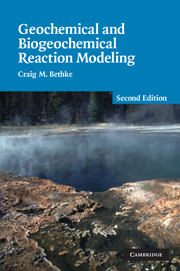Book contents
- Frontmatter
- Contents
- Preface
- Preface to first edition
- A note about software
- 1 Introduction
- 2 Modeling overview
- Part I Equilibrium in natural waters
- Part II Reaction processes
- 13 Mass transfer
- 14 Polythermal, fixed, and sliding paths
- 15 Geochemical buffers
- 16 Kinetics of dissolution and precipitation
- 17 Redox kinetics
- 18 Microbial kinetics
- 19 Stable isotopes
- 20 Transport in flowing groundwater
- 21 Reactive transport
- Part III Applied reaction modeling
- Appendix 1 Sources of modeling software
- Appendix 2 Evaluating the HMW activity model
- Appendix 3 Minerals in the LLNL database
- Appendix 4 Nonlinear rate laws
- References
- Index
16 - Kinetics of dissolution and precipitation
Published online by Cambridge University Press: 05 August 2012
- Frontmatter
- Contents
- Preface
- Preface to first edition
- A note about software
- 1 Introduction
- 2 Modeling overview
- Part I Equilibrium in natural waters
- Part II Reaction processes
- 13 Mass transfer
- 14 Polythermal, fixed, and sliding paths
- 15 Geochemical buffers
- 16 Kinetics of dissolution and precipitation
- 17 Redox kinetics
- 18 Microbial kinetics
- 19 Stable isotopes
- 20 Transport in flowing groundwater
- 21 Reactive transport
- Part III Applied reaction modeling
- Appendix 1 Sources of modeling software
- Appendix 2 Evaluating the HMW activity model
- Appendix 3 Minerals in the LLNL database
- Appendix 4 Nonlinear rate laws
- References
- Index
Summary
To this point we have measured reaction progress parametrically in terms of the reaction progress variable ξ, which is dimensionless. When in Chapter 13 we reacted feldspar with water, for example, we tied reaction progress to the amount of feldspar that had reacted and expressed our results along that coordinate. Studying reactions in this way is in many cases perfectly acceptable. But what if we want to know how much time it took to reach a certain point along the reaction path? Or, when modeling the reaction of granite with rainwater, how can we set the relative rates at which the various minerals in the granite dissolve? In such cases, we need to incorporate reaction rate laws from the field of geochemical kinetics.
The differences between the study of thermodynamics and kinetics might be illustrated (e.g., Lasaga, 1981a) by the analogy of rainfall on a mountain. On the mountaintop, the rainwater contains a considerable amount of potential energy. With time, it flows downhill, losing energy (to be precise, losing hydraulic potential, the mechanical energy content of a unit mass of water; Hubbert, 1940), until it eventually reaches the ocean, its lowest possible energy level. The thermodynamic interpretation of the process is obvious: the water seeks to minimize its energy content.
But how long will it take for the rainfall to reach the ocean? The rain might enter a swift mountain stream, flow into a river, and soon reach the sea. It might infiltrate the subsurface and migrate slowly through deep aquifers until it discharges in a distant valley, thousands of years later.
- Type
- Chapter
- Information
- Geochemical and Biogeochemical Reaction Modeling , pp. 231 - 244Publisher: Cambridge University PressPrint publication year: 2007

